Antique mantel clocks hold a special place in the world of timekeeping. As a collector, enthusiast, or someone fascinated by the intricacies of these beautiful pieces, you may have found yourself seeking guidance on how to identify and determine their value. This article aims to provide you with the information you need to navigate the world of antique mantel clocks and help you confidently appraise them.
Depending on their age, shape, materials, and brands, antique mantel clocks can vary greatly in value. Popular types of mantel clocks include Ansonia Mantel Clocks from the 1870s – 1900s, Atmos Shelf Clocks from the 1930s – 1940s, and Tambour Mantel Clocks from the 1900s – 1920s, among others. By familiarizing yourself with the different styles, periods, and manufacturers, you will be better equipped to identify the age and rarity of a clock, which are crucial factors when determining its worth.
In the article that follows, gather insights into the various factors that affect the value of an antique mantel clock. Learn about the historical context of these timepieces and the many characteristics that contribute to their unique charm. As you delve deeper into the captivating world of antique mantel clocks, discover how to enhance your collection or transform the look of your home with a carefully selected piece.
Table of Contents
The History & Evolution of Antique Mantel Clocks
In the early 18th century, mantel clocks emerged as a popular choice for timekeeping in homes. As you explore the history of antique mantel clocks, you will notice the influence of various countries, including America and France, as well as the contributions of renowned clockmakers.
France played a significant role in the development of mantel clocks, particularly during the 18th and 19th centuries. French clockmakers were known for their elaborate and decorative designs, often featuring intricate ornaments made of bronze, porcelain, or marble. These sophisticated, artistic clocks became highly sought-after by collectors and enthusiasts around the world.
America entered the world of mantel clocks in the early 19th century, as industrialization expanded production capabilities. Key American clockmakers include Eli Terry, Seth Thomas, and Ansonia.
- Eli Terry pioneered mass production techniques for clock manufacturing in the early 1800s. His innovations in creating interchangeable parts for wooden clocks made them more affordable and accessible to the general public.
- Seth Thomas founded the Seth Thomas Clock Company in 1813, which became one of the most well-known and respected American clock manufacturers. Known for producing high-quality clocks with various materials like wood, brass, and glass, Seth Thomas clocks gained popularity across the country.
- Ansonia, based in Ansonia, Connecticut, and later New York City, was another prominent American manufacturer of mantel and wall clocks. Established in 1851, the Ansonia Clock Company was famous for producing detailed, ornately designed clocks that were both functional and visually appealing.
The Willard Brothers – Simon, Aaron, and Benjamin – also made significant contributions to the evolution of mantel clocks in America. Their iconic “lighthouse clock,” developed in the early 19th century, combined the practicality of a timekeeper with the aesthetics of a decorative item.
Throughout history, the designs and materials of mantel clocks have continuously evolved, reflecting changes in technology, craftsmanship, and style. By understanding the contributions of various countries, manufacturers, and clockmakers, you can appreciate the unique characteristics and value of each antique mantel clock in your collection.
Styles of Antique Mantel Clocks
Session Expired
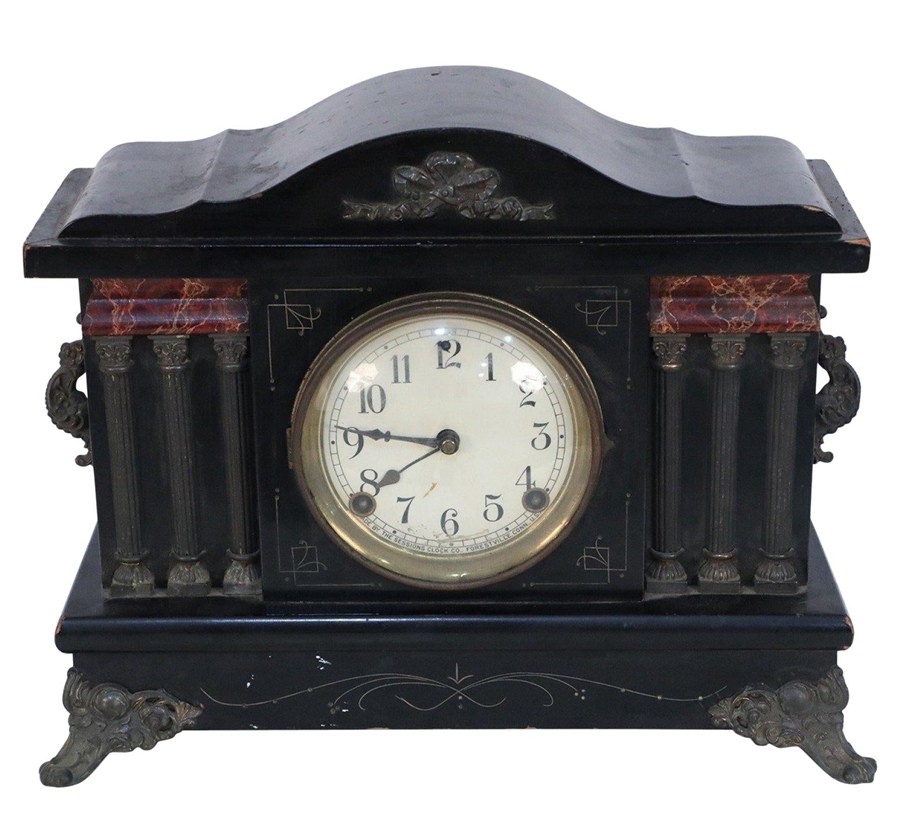
Session expired clocks show off intricate, delicate designs and fine craftsmanship. Usually made of brass, they have elegant and ornate hands. They’re wound with a key at intervals, and typical antique mantel clocks are “8-day”, meaning you wound them once in eight days.
Bracket Clocks

Bracket clocks are mainly inspired by classic European architecture and often feature beautiful wooden casings. They were common in the 1700s and 1800s and are known for their detailed ornamentation and chimes.
Steeple Clocks
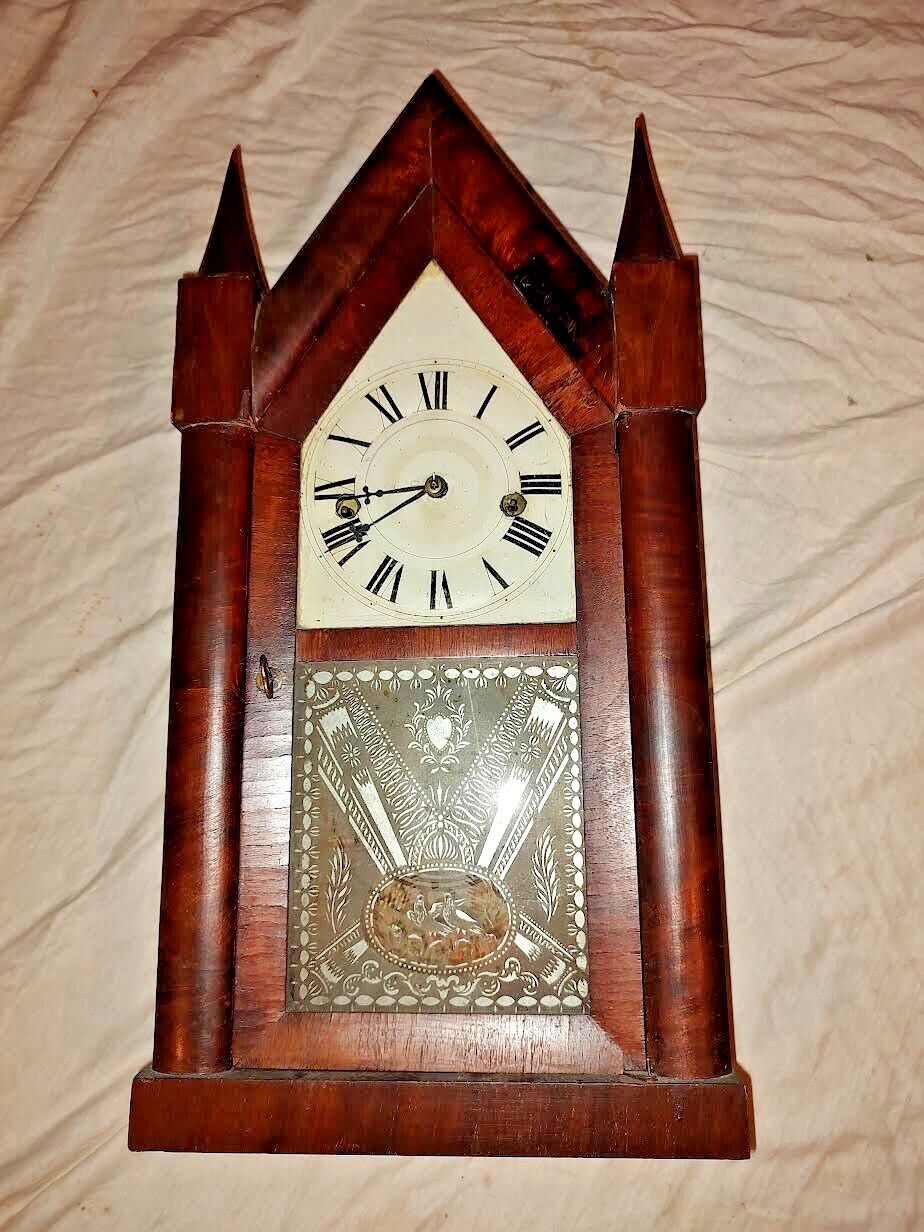
Steeple clocks gained popularity in the mid-19th century. They have a distinct triangular shape, resembling a church steeple. Manufacturers often used veneered wood with gothic-inspired details for the casings.
Ogee Clocks
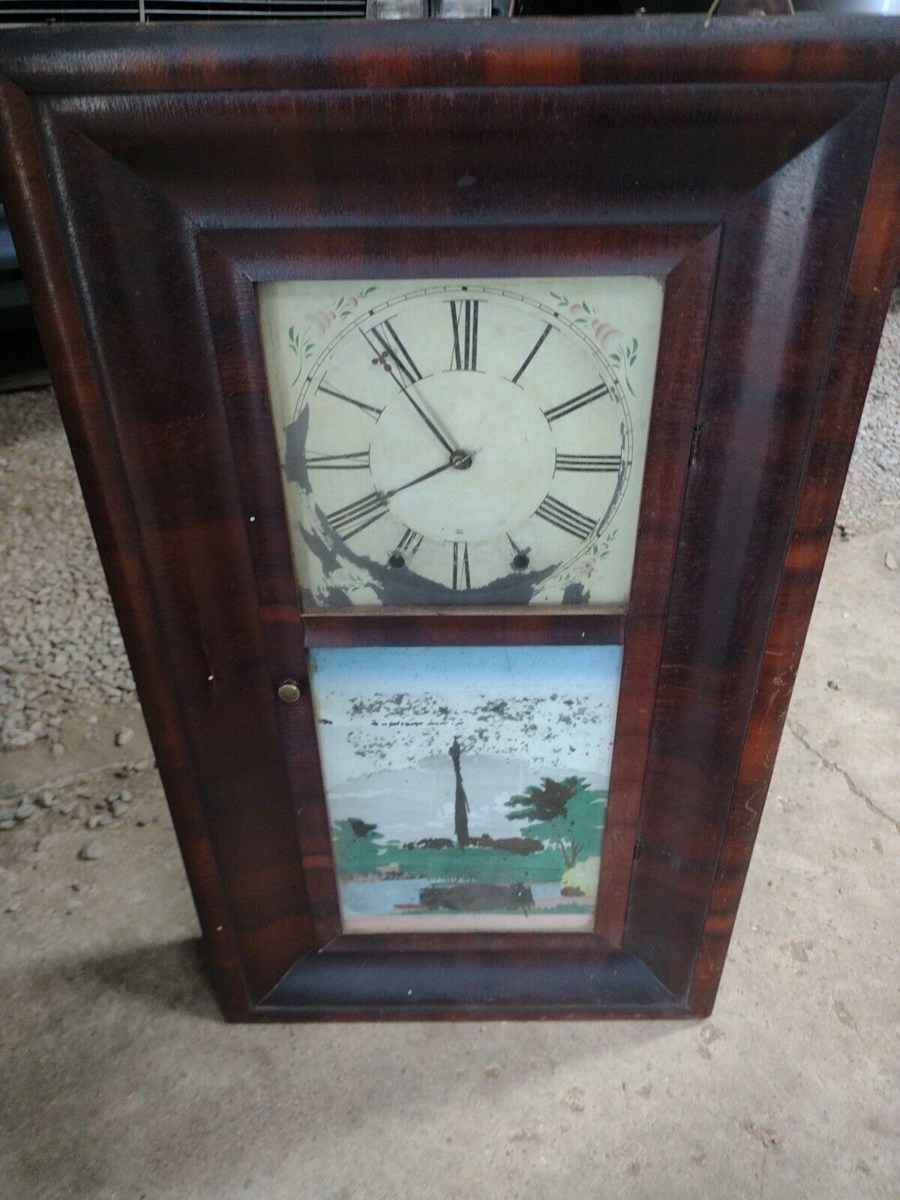
Ogee clocks showcase a distinctive S-shaped curve in their design. These clocks usually had elaborate wooden or metal cases with painted glass panels. They were popular during the first half of the 19th century.
Beehive Clocks
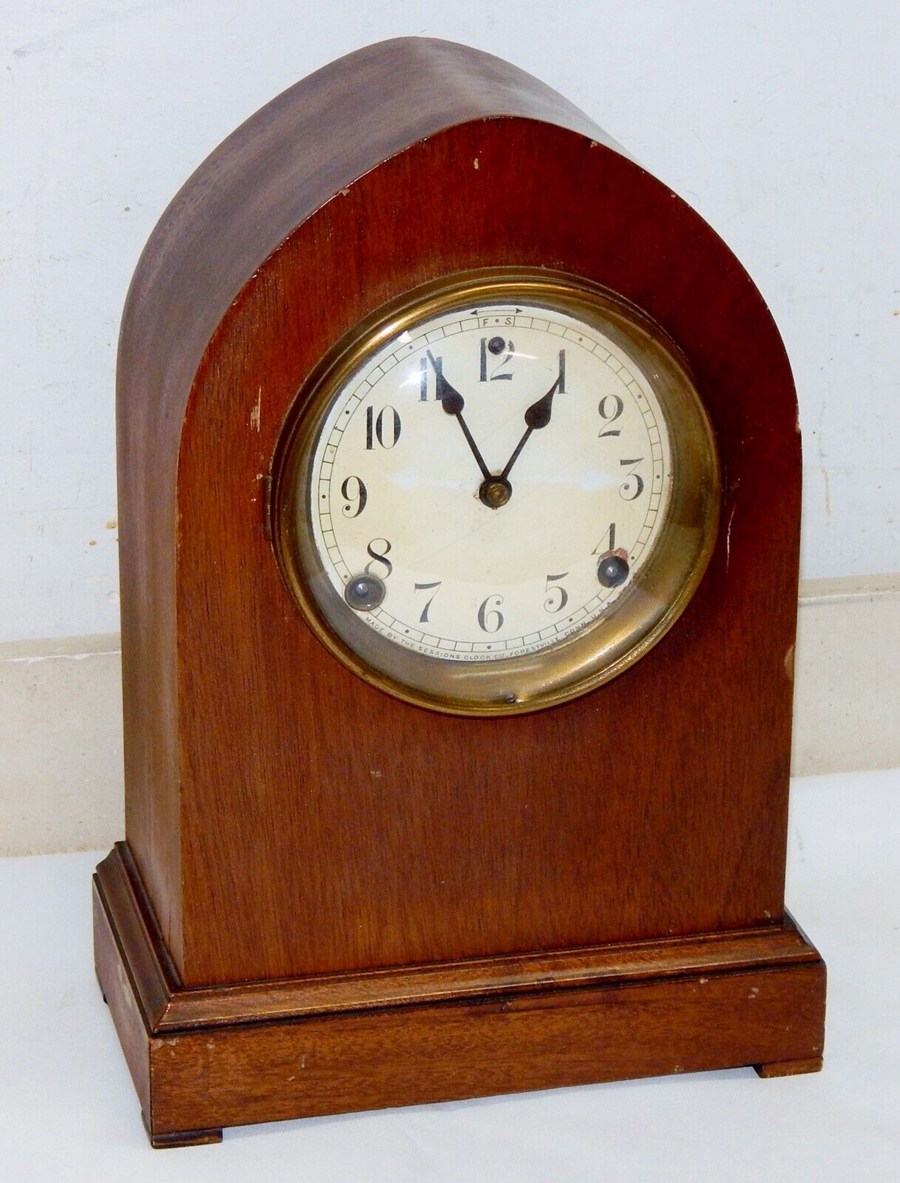
The beehive clock’s main feature is its unique domed shape, which resembles a beehive. These clocks were popular during the 19th century and typically had wooden cases with glass doors and elaborate handpainted designs.
Tambour Clocks
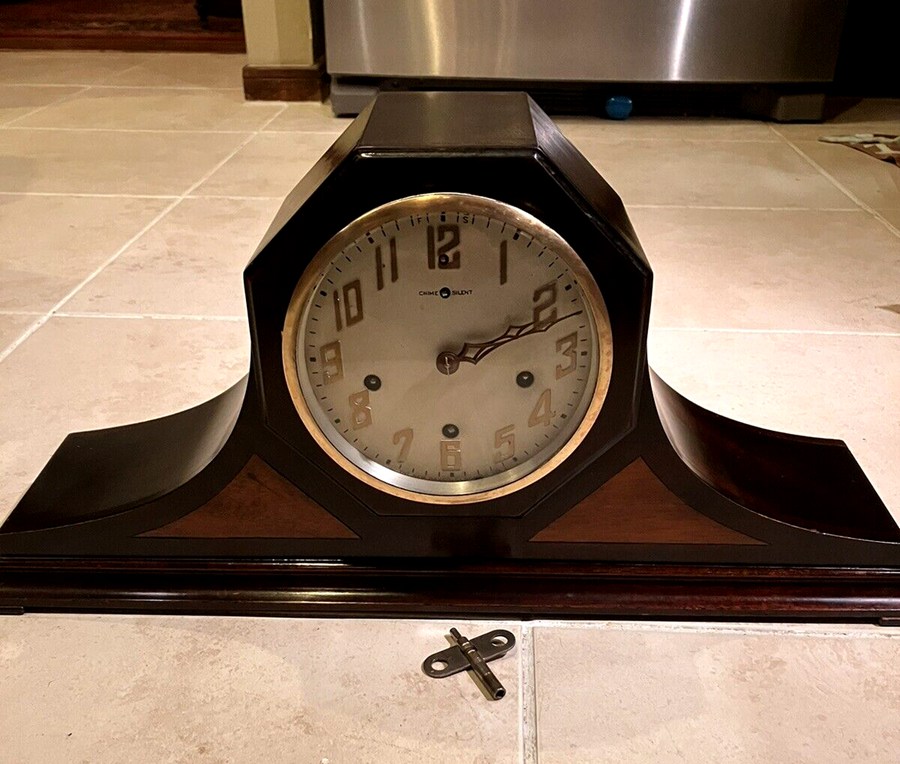
Tambour clocks have a curved, horizontal profile with a wide, low stance. This design gives them a sleek and modern appearance. Tambour clocks gained popularity in the early 20th century, often featuring wooden cases and polished metal accents.
Black Mantel Clocks
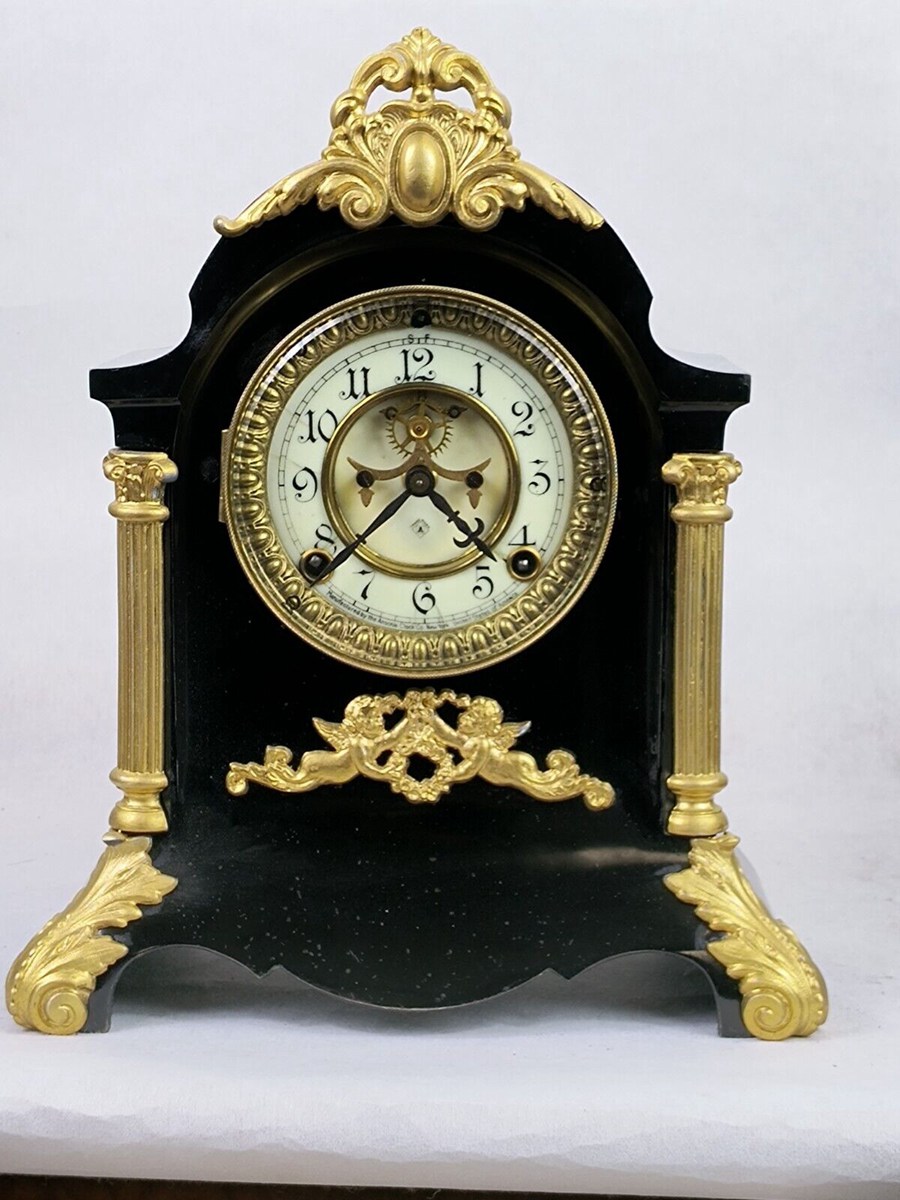
Black mantel clocks are characterized by their bold black casings, usually made from wood, slate, or marble. They became popular during the 1800s-1900s and often included intricate details in gold or silver accents.
Art Deco and Modern Styles
Art Deco style clocks emerged in the 1920s and 1930s, featuring geometric shapes, bold lines, and vibrant colors. They often combined various materials such as wood, brass, and glass. Modern style clocks contrasted with the traditional ones, opting for minimalist designs and simple forms
In terms of value, an 1890s Seth Thomas Adamantine “Butterscotch” Mantel Clock was sold for $145 on eBay. As you begin to identify and assess the value of your antique mantel clock, remember to take factors such as age, rarity, and condition into consideration.
10 Factors That Affect Antique Mantel Clocks Values
1. Maker’s Mark
When identifying antique mantel clocks, one of the key factors to consider is the maker’s mark. This mark can usually be found on the clock’s dial or mechanism and serves as an indication of the clock’s manufacturer. Knowing the maker of your antique clock can significantly affect its value. To help you evaluate your mantel clock, we’ve compiled a simple valuation table below that considers the maker’s mark.
| Maker’s Mark | Average Valuation |
|---|---|
| Kienzle Clock | $500 – 600 |
| Ansonia Clock Co. | $400 – 500 |
| Seth Thomas Clock | $300 – 400 |
| French Regency | $350 – 450 |
| Swiss Clock | $250 – 300 |
| Unmarked Clock | $100 – 200 |
In addition to the maker’s mark, other factors may also influence the value of your antique clock. These include the clock’s age, rarity, condition, and any unique features it may possess. However, the maker’s mark remains one of the most reliable indicators of value, as it reflects the craftsmanship and reputation associated with a particular manufacturer.
When examining your clock for identification purposes, make sure to look closely at the dial and mechanism, as the maker’s mark may be small or hidden. In some cases, clocks may have multiple markings, including the maker’s mark, patent numbers, and country of origin. These details can help provide a more accurate valuation and aid in determining the clock’s authenticity.
So, when evaluating your antique mantel clock, first and foremost, pay attention to the maker’s mark. Use the valuation table provided to get a rough estimate of its value based on the clock’s manufacturer. And remember to consider additional factors like age, rarity, and condition for a more comprehensive assessment.
2. Age
The age of your antique mantel clock can greatly influence its value. Over the years, several design features and materials have evolved, making it easy to identify the age of the mantel clock.
Pre-1820s
In the early years of mantel clock production, they were predominantly crafted from wood, including the movement, dials, and fittings. Common woods used were oak, mahogany, and cherry.
1840s onwards
From the 1840s, brass became a popular material for clock movements. This shift in preference is a helpful indicator for dating a mantel clock.
| Age | Common Features |
|---|---|
| Pre-1820s | Wood construction |
| 1840s and later | Brass clock movements |
To further identify the age of your antique mantel clock, consider the manufacturer’s name on the clock face and any additional markings on the case or movement. Examining the overall style, craftsmanship, and quality can also provide insight into the clock’s age.
Valuation of antique mantel clocks depends on several factors, such as age, condition, rarity, and historical significance. Below is a table outlining average valuations based on age:
| Age | Average Valuation |
|---|---|
| Pre-1820s | $1,500 – 2,000 |
| 1820s – 1830s | $1,000 – 1,500 |
| 1840s – 1850s | $800 – 1,200 |
| 1860s – 1870s | $500 – 800 |
| 1880s – 1890s | $300 – 500 |
| 1900s – 1910s | $200 – 400 |
| 1920s – 1930s | $150 – 300 |
Remember that these valuations are approximate; actual values may vary based on individual factors and market demand. It is always recommended to consult with a professional appraiser for a more accurate assessment of your antique mantel clock’s value.
3. Style and Design
When it comes to identifying antique mantel clocks, understanding their style and design is crucial. There are several distinct styles of mantel clocks, and each has its own unique characteristics and value ranges. In this section, we will guide you through the most common styles of mantel clocks and help you to get a solid grasp on their respective values.
French Style Mantel Clocks
- Originating in France, these early timepieces often feature gilt-metal finishings and architectural designs.
- Their intricate detailing and ornate designs make them highly desirable among collectors.
| French Style Features | Average Valuation |
|---|---|
| Gilt-metal finishings | $500 – $600 |
| Architectural style | $450 – $500 |
Ansonia Mantel Clocks
- Produced by the Ansonia Clock Company, these clocks are known for their ornate cases and decorative elements.
- They come in a variety of styles, such as cast iron, Adamantine, and Art Deco.
| Ansonia Clock Features | Average Valuation |
|---|---|
| Cast Iron | $200 – $300 |
| Adamantine | $100 – $200 |
| Art Deco | $50 – $150 |
Seth Thomas Mantel Clocks
- Seth Thomas, a prominent American clockmaker, is known for producing high-quality mantel clocks with varying designs.
- You can identify these clocks by their unique cases, often made of materials such as wood, brass, or adamantine.
| Seth Thomas Clock Features | Average Valuation |
|---|---|
| Wooden case | $150 – $250 |
| Brass case | $200 – $300 |
| Adamantine case | $100 – $200 |
By familiarizing yourself with these styles and their corresponding values, you can more easily identify and appraise antique mantel clocks in your collection or for potential purchase. Always assess the condition, age, and rarity of a clock in addition to its style to achieve the most accurate valuation.
4. Materials Used
Antique mantel clocks can be made from a variety of materials, which can have a significant impact on their value. In this section, you will find a breakdown of the common materials used in antique mantel clocks and their corresponding valuation ranges.
Wood
Pre-1820s, mantel clocks were primarily made from wood, including oak, mahogany, and cherry wood. The use of wood persisted up to the 1880s-1930s, with many clocks finished in black enamel to make them look more expensive.
Wood Types and Valuation:
| Wood Type | Average Valuation |
|---|---|
| Oak | $250 – 350 |
| Mahogany | $300 – 400 |
| Cherry Wood | $200 – 300 |
| Black Enamel | $150 – 250 |
Brass
From the 1840s onwards, brass became a common material for clock movements. The use of brass materials can indicate both craftsmanship and value in an antique mantel clock.
Brass Valuation:
| Clock Type | Average Valuation |
|---|---|
| Brass Movement with Wood Exterior | $300 – 500 |
| Brass Movement and Exterior | $500 – 700 |
Bronze, Stone, and Porcelain
Bronze and stone mantel clocks are typically handcrafted and more valuable than other materials. Porcelain clocks, while not as common, can also fetch a high value due to their rarity and elaborate designs.
Bronze, Stone, and Porcelain Valuation:
| Material | Average Valuation |
|---|---|
| Bronze | $600 – 800 |
| Stone | $500 – 700 |
| Porcelain | $400 – 600 |
Remember that these valuation ranges are just a guide and can vary depending on factors such as age, rarity, and condition. Always consult with an expert when determining the value of your antique mantel clock.
5. Movement Type
When identifying and valuing antique mantel clocks, one key aspect to consider is the movement type. Movements can be broadly categorized into mechanical and quartz types.
Mechanical Movements
Antique mantel clocks typically feature mechanical movements, which require winding at regular intervals using a key. These 8-day movements are quite common, meaning you only need to wind the clock once every eight days. The craftsmanship of mechanical movements can greatly influence the value of an antique mantel clock.
| Mechanical Movement Features | Average Valuation |
|---|---|
| Basic 8-day movement | $200 – 300 |
| Ornate, engraved movement | $400 – 500 |
| Complicated chime system | $600 – 800 |
Quartz Movements
Quartz movements are more typically found in vintage clocks, as opposed to antiques. These battery-powered movements are more modern and don’t require winding like their mechanical counterparts. Although quartz movements replaced mechanical ones, the value of clocks with this type of movement is generally lower.
| Quartz Movement Features | Average Valuation |
|---|---|
| Basic quartz movement | $50 – 100 |
| Complicated chime system | $150 – 250 |
In summary, when identifying antique mantel clocks, the movement type plays a crucial role in determining the value. With a focus on mechanical movements, consider the intricacy and quality of the clock’s mechanisms, as it could greatly affect its worth.
6. Complexity and Features
When identifying antique mantel clocks and determining their value, it’s essential to consider the complexity and features of the clock. Various aspects, such as the clock’s age, materials, and brand, can significantly impact its worth.
Clock’s Age
The age of a mantel clock is one of the primary factors in determining its value. Older clocks often hold a higher value due to their rarity and historical significance. The following table presents the age of several mantel clock types along with their average valuation:
| Clock Type | Approximate Time Period | Average Valuation |
|---|---|---|
| Ansonia Mantel Clocks | 1870s – 1900s | $200 – $600 |
| Atmos Shelf Clocks | 1930s – 1940s | $600 – $800 |
| Bracket Mantel Clocks | 1700s – 1720s | $1,500 – $3,000 |
| Steeple Rack Clocks | 1750s – 1800s | $400 – $700 |
| Skeleton Shelf Clocks | 1840s – 1860s | $250 – $400 |
| Tambour Mantel Clocks | 1900s – 1920s | $100 – $300 |
Materials
The materials used to construct an antique mantel clock can significantly impact its valuation. Typically, higher-quality materials such as solid wood or precious metals indicate a more valuable clock. Here’s a table with various materials and their respective valuations:
| Material | Average Valuation |
|---|---|
| Wood | $150 – $350 |
| Gilded Bronze | $300 – $800 |
| Brass | $200 – $500 |
| Porcelain | $250 – $700 |
Antique Mantel Clock Brands
Lastly, certain brands are known for their craftsmanship and quality, which can further influence a clock’s value. The table below displays a few reputable mantel clock brands and their associated valuations.
| Clock Brand | Average Valuation |
|---|---|
| Ansonia | $200 – $600 |
| Seth Thomas | $150 – $400 |
| New Haven | $100 – $300 |
| Waterbury Clock Company | $150 – $500 |
Considering these factors and examining your mantel clock’s complexity and features can help you better determine its value. However, it’s essential to consult an expert for a more precise evaluation, as intricacies and rarity can also impact the clock’s worth.
7. Condition
When identifying and valuing antique mantel clocks, the condition of the clock is one of the most crucial factors to consider. In this section, we will discuss various aspects related to the condition of antique mantel clocks.
Firstly, you should closely inspect the clock for any signs of damage, such as cracks, chips, or fading. A clock in poor condition will likely have a lower value compared to one in excellent or mint condition. Additionally, look for signs of restoration or repairs, as this may also affect the value.
Other factors to consider when evaluating the condition of an antique mantel clock include the clock’s age, shelf clock’s shape, dial color, brand, and materials used in the clock. To assist you in determining how these factors impact the value of an antique mantel clock, here’s a valuation table:
| Factor | Average Valuation |
|---|---|
| Age (Older clocks) | Higher value |
| Shelf Clock’s Shape | Unique shapes fetch more value |
| Dial Color | Rarer colors – higher value |
| Antique Mantel Clock Brands | Renowned brands – higher value |
| Clock Materials | High-quality materials – more value |
Please remember that these are rough estimates, and the actual value of your antique mantel clock may vary depending on various factors. It’s essential to consult with experts or refer to price guides and auction results when determining the value of your clock.
8. Rarity
When it comes to antique mantel clocks, rarity plays a significant role in determining their value. Certain factors affect the rarity and subsequently the value of these timepieces, such as mantel clock age, shape, materials used, the clockmaker, and specific features.
Here’s a valuation table for the rarity factors that affect the value of antique mantel clocks:
| Factor | Average Valuation |
|---|---|
| Age | $250 – 300 |
| Shape | $300 – 400 |
| Materials | $350 – 450 |
| Clockmaker | $400 – 500 |
| Specific Features | $450 – 600 |
Age
Older mantel clocks tend to be rarer, as fewer have survived over time. So, the age of your mantel clock can significantly impact its worth. Generally, older clocks are more valuable, but this may vary based on other factors.
Shape
The shape of antique mantel clocks can vary based on the era and the clockmaker. Certain shapes are rarer and more sought after due to their artistic design. Keep an eye out for unique shapes as they may significantly increase the value of the clock.
Materials
Antique mantel clocks were made from various materials, either separately or combined. Rarer materials such as fine wood, brass, bronze, or porcelain can contribute to the timepiece’s overall value. The quality of workmanship and state of preservation also play a role in valuation.
Clockmaker
Some clockmakers are particularly renowned and collectible. If your mantel clock was made by a highly regarded clockmaker, this could greatly enhance its value. However, even lesser-known clockmakers could produce clocks with intricate designs and high-quality materials, thereby increasing their rarity and worth.
Specific Features
Certain features in antique mantel clocks may increase their rarity, such as specific hand movements, innovative designs, or limited edition models. These unique features could add significant value to your mantel clock. Pay close attention to the clock’s mechanisms and identifying marks to determine if it has any rare, collectible features.
Remember that rarity is just one factor affecting the value of antique mantel clocks. When evaluating your timepiece, consider these factors in combination with the clock’s overall condition, historical significance, and aesthetic appeal.
9. Historical Significance
The antique mantel clock originated in 18th century France during the Napoleon Era, often displaying exquisite craftsmanship and intricate designs. Highly sought after by collectors and interior decorators, these timepieces reflect important cultural and artistic influences of their time. There are various types of antique mantel clocks that include different styles, shapes, and materials utilized throughout the centuries. In this section, we will discuss the historical significance of these beautiful clocks and how their value is determined.
When identifying antique mantel clocks, several factors can affect their value, including age, shape, dial color, brand, and the materials used. Here is a table that outlines the general valuation range for different antique mantel clock characteristics:
| Clock’s Age | Average Valuation |
|---|---|
| 1700s | $1,500 – 2,000 |
| 1800s | $1,000 – 1,500 |
| 1900s | $500 – 1,000 |
| Shelf Clock Shape | Average Valuation |
|---|---|
| Ansonia Mantel Clocks | $400 – 600 |
| Atmos Shelf Clocks | $800 – 1,200 |
| Bracket Mantel Clocks | $1,800 – 2,500 |
| Steeple Rack Clocks | $300 – 500 |
| Skeleton Shelf Clocks | $600 – 800 |
| Tambour Mantel Clocks | $200 – 400 |
| Dial Color | Average Valuation |
|---|---|
| White | $100 – 200 |
| Silver | $200 – 300 |
| Gold | $300 – 400 |
| Black | $400 – 500 |
| Antique Mantel Clock Brand | Average Valuation |
|---|---|
| Ansonia | $400 – 600 |
| Atmos | $800 – 1,200 |
| Clock Materials | Average Valuation |
|---|---|
| Wood | $100 – 200 |
| Brass | $200 – 300 |
| Marble | $300 – 400 |
| Gilt Bronze | $400 – 500 |
Keep in mind that these valuations are just average ranges and may vary depending on the specific clock’s condition, rarity, and provenance. When determining the value of your antique mantel clock, consult reputable sources, consult with experts, and consider the factors mentioned to ensure that you receive an accurate valuation.
10. Market Demand
Antique mantel clocks are highly sought-after by collectors and interior designers due to their distinctive, classic looks and intricate mechanics. The demand for these timepieces is influenced by factors such as age, make, materials, shape, and more. Here’s a brief overview of some aspects that can affect the value of an antique mantel clock.
Age
Older clocks tend to be more valuable, as they are rarer and showcase a unique style that’s harder to find today. When estimating the value of your antique mantel clock, take its age into consideration; clocks made during the 18th and 19th centuries are usually considered more collectible than those produced in the 20th century.
Make and Materials
The quality and craftsmanship of the clock play a crucial role in determining its value. Some well-known manufacturers, like Kienzle Clock, command higher prices due to their reputation for producing high-quality timepieces. Additionally, the materials used in making the clock, such as cast-iron or marble, can impact its value.
Shape
The shape of a mantel clock can significantly influence its value. Unique and intricate shapes, such as bird or angel designs, can fetch higher prices than simple, geometric forms. Here’s a valuation table based on the shape of the clock:
| Clock Shape | Average Valuation |
|---|---|
| Ornate Bird or Angel Design | $600 – 700 |
| Simple Cuboidal | $200 – 250 |
| Rounded Rectangle with Carved Details | $350 – 400 |
| Tall, Narrow, and Elegant Form | $500 – 550 |
| Drum-like Form with Extended Base | $450 – 500 |
Use this table as a general guide for determining the value of your antique mantel clock. Keep in mind that other factors, like the clock’s condition and rarity, can also play a role in its actual market value. Taking these factors into consideration will give you a better understanding of your timepiece’s worth and help you navigate the market demand for antique mantel clocks.
Final Thoughts
As you explore the world of antique mantel clocks, it’s essential to familiarize yourself with the various factors that influence their identification and value. Consider these key points:
- Take note of a clock’s age, design, and rarity. Each of these aspects can significantly impact the clock’s worth.
- Pay attention to manufacturer marks and serial numbers when applicable, as these can help you correctly identify the clock and its age.
- Consult a knowledgeable appraiser to ensure that you are accurately identifying and assessing the value of an antique mantel clock. This expert opinion can be invaluable in understanding the intricate details of clock identification and valuation.
By carefully studying these aspects of antique mantel clocks, you can become more adept at identifying and valuing these unique timepieces. Remember to trust your instincts and seek expert advice as needed. Happy clock hunting!
FAQ
How can I identify the age of my mantel clock?
You can determine the age of your mantel clock by looking at its materials, design, and any manufacturer labels or markings. For example, wooden mantel clocks with wooden movements, dials, and fittings usually date back to the pre-1820s. Between 1840s and 1930s, brass became common in clock movements, while wooden clocks were often finished with black enamel to mimic a more expensive appearance.
What are some common styles of antique mantel clocks?
Some common styles of antique mantel clocks include:
- French gilt bronze mantel clocks from the 19th century
- Ansonia clocks made in the United States in the late 19th and early 20th centuries
- Regency bracket clocks from 18th-century France
Experienced collectors may be able to identify a brand or maker based on specific design features.
Can you give me any tips on how to properly handle and care for my antique mantel clock?
To ensure the proper care and handling of your antique mantel clock:
- Keep it clean: Dust the exterior regularly using a soft, dry cloth, taking care not to apply excessive pressure or scratch the surface.
- Avoid direct sunlight: Prolonged exposure to sunlight can fade the colors and damage the materials. Place your clock in a shaded area away from direct sunlight.
- Mind the humidity: Too much humidity can cause the wood to warp or metal components to corrode. Keep your clock in an environment with stable humidity levels.
- Adjust the pendulum: For clocks with a pendulum, ensure it is set correctly to keep accurate time. Use a level to make sure the clock is straight and the pendulum is swinging freely.
Are there any resources available to help me determine the value of my mantel clock?
Yes, there are several resources you can consult to help determine the value of your mantel clock:
- Auction results: Check online auction websites and auction house archives for similar mantel clocks. This can give you an idea of the market value.
- Antique clock collectors: Join online forums or antique clock clubs to consult with fellow enthusiasts who might have knowledge about your specific clock model.
- Antique clock valuation guides: Some antique clock books and online resources may provide price guides or ranges for specific clock styles and manufacturers.
Remember to consider factors such as condition, rarity, age, and provenance when determining the value of your mantel clock.









